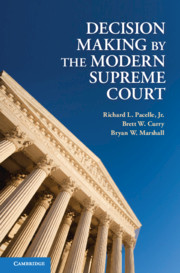Book contents
- Frontmatter
- Contents
- Acknowledgments
- 1 The Supreme Court
- 2 Heuristic Models of Judicial Decision Making
- 3 Building an Integrated Model of Decision Making
- 4 Decision Making on the Modern Supreme Court
- 5 Building a New Legacy
- 6 Sharing the Protection of Minorities
- 7 Avoiding Another Self-Inflicted Wound
- 8 Policing the Boundaries
- 9 Conclusion
- Measurement Appendix
- Cases Cited
- References
- Index
8 - Policing the Boundaries
Statutory Economic Issues
Published online by Cambridge University Press: 05 June 2012
- Frontmatter
- Contents
- Acknowledgments
- 1 The Supreme Court
- 2 Heuristic Models of Judicial Decision Making
- 3 Building an Integrated Model of Decision Making
- 4 Decision Making on the Modern Supreme Court
- 5 Building a New Legacy
- 6 Sharing the Protection of Minorities
- 7 Avoiding Another Self-Inflicted Wound
- 8 Policing the Boundaries
- 9 Conclusion
- Measurement Appendix
- Cases Cited
- References
- Index
Summary
Leave it to New Yorkers. Only in New York would a court of original jurisdiction be called the Supreme Court. Of course, this begs the question of what one should call courts higher than the “Supreme Court.” It seems that the United States and most states have it right: The Supreme Court is the final court, and its decisions are superior to all others. However, not every case decided by the Supreme Court is a monumental decision that reshapes the legal landscape. Some state supreme courts, like Montana and Wyoming, have mandatory jurisdiction, meaning that they need to hear every case properly brought to the docket. The U.S. Supreme Court faced similar constraints until Congress altered its jurisdiction in 1925 (Estreicher and Sexton 1986; Pacelle 1991).
In 1988, Congress intervened again to cut the Court's mandatory jurisdiction even further (Pacelle 1991; Perry 1991). Nevertheless, it is still possible for the U.S. Supreme Court to end up with some cases that are, shall we say, “less equal than others.” Not every case yields a life-altering decision. For every Supreme Court decision that makes the front page of the New York Times or the table of contents of a Constitutional law textbook, there are scores of decisions that hardly cause a ripple. The luxurious quarters of the Supreme Court and its modern authority and impact give it a quasireligious aura. When that power and aura are combined with the normative concepts of law and justice, the Court casts a considerable shadow.
- Type
- Chapter
- Information
- Decision Making by the Modern Supreme Court , pp. 167 - 198Publisher: Cambridge University PressPrint publication year: 2011



